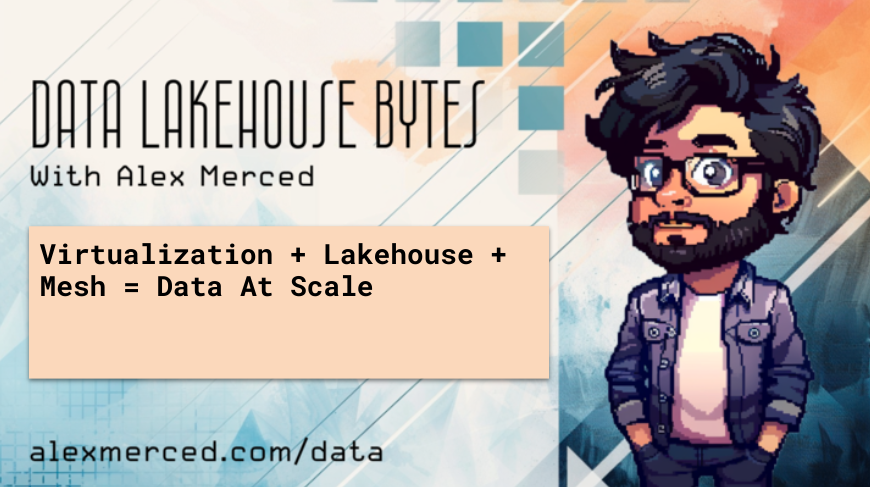Virtualization + Lakehouse + Mesh = Data At Scale
 Alex Merced
Alex Merced
As data continues to grow exponentially in scale, speed, and variety, organizations are grappling with the challenges of managing and leveraging vast amounts of information. Traditional data architectures, reliant on extensive pipelines and disparate data in databases, data lakes and warehouses each with their own user access and governance challenges, are proving too slow, rigid, and costly to meet modern business needs. The crux of the problem lies in data silos—isolated pockets of data curated by a central team—that hinder collaboration, slow decision-making, and lead to inefficiencies.
The Paradigm Shift: Centralized Access Curated by Many
To overcome these challenges, a better approach is to flip the script and instead of users accessing data scattered across many places curated by a central team, have users accessing data in a centralized place curated by many teams. This approach combines:
- Data Unification: Providing centralized access to all data, breaking down silos and enabling seamless analytics.
- Data Decentralization: Empowering individual teams to manage and prepare their own data assets, fostering flexibility and innovation.
By unifying data access while decentralizing its ownership and preparation, organizations can achieve enhanced collaboration, improved data quality, and faster time-to-insight.
Trends Driving the Transformation
Three key trends are propelling this shift:
Data Lakehouse: A hybrid architecture that combines the storage capabilities of data lakes with the analytical power of data warehouses. It allows for unified storage and analytics using open formats, supporting diverse workloads and simplifying data management.
Data Virtualization: Technology that provides real-time access to data across multiple sources without moving or duplicating it. It offers a unified view of data, reducing data movement, and enabling agile decision-making.
Data Mesh: A decentralized approach assigning data ownership to domain-specific teams. It treats data as a product, managed with the same rigor as customer-facing offerings, enhancing scalability and innovation.
Dremio: Bridging Centralized Access and Decentralized Management
Dremio is a data lakehouse platform that uniquely combines data unification and decentralization. Here's how Dremio enables this paradigm shift:
Unified Data Access: Dremio's platform allows users to access and analyze data from various sources through a single interface, overcoming data silos without the need for data movement or duplication. Dremio provides access to databases (postgres, mongo, etc.), data lakes (S3, ADLS, Minio, etc.), data warehouses (Snowflake, Redshirt, etc.) and Lakehouse Catalogs (AWS Glue, Apache Polaris (incubating), Hive, etc.) all in one unified access point.
Empowering Teams: By supporting data decentralization, Dremio enables domain teams to manage and prepare their own data using preferred tools and systems, ensuring data quality and relevance.
Open-Source Foundation: Leveraging technologies like Apache Arrow for high-performance in-memory processing, Apache Iceberg for robust data lakehouse capabilities, and Project Nessie for version control and governance, Dremio ensures flexibility and avoids vendor lock-in.
Performance and Scalability: Dremio's architecture, built on these open-source technologies, delivers enhanced query performance, scalability, and supports diverse analytics workloads.
Benefits of the New Approach with Dremio
Enhanced Collaboration: Centralized access to data curated by various teams fosters collaboration and consistent data usage across the organization.
Improved Data Quality: Domain experts manage their data products, leading to more accurate and contextually relevant datasets.
Operational Efficiency: Reduces redundant efforts and streamlines workflows, lowering costs and resource utilization.
Agility and Innovation: Decentralized teams can rapidly adapt and innovate without impacting the entire system, enabling quicker responses to market changes.
Conclusion
Organizations must adopt innovative solutions to unlock the full potential of their data assets. By shifting to a model where users access data in a centralized place curated by many teams, businesses can overcome the limitations of traditional data architectures. Dremio's unique combination of data unification and decentralization, powered by cutting-edge open-source technologies, positions it as the ideal platform to enable this paradigm shift.
Read This Article for a Deeper Exploration of Dremio's Centralization through Decentralization
Resources to Learn More about Iceberg
Subscribe to my newsletter
Read articles from Alex Merced directly inside your inbox. Subscribe to the newsletter, and don't miss out.
Written by

Alex Merced
Alex Merced
Alex Merced is a developer advocate at Dremio with experience as a developer and instructor. His professional journey includes roles at GenEd Systems, Crossfield Digital, CampusGuard, and General Assembly. He co-authored "Apache Iceberg: The Definitive Guide" published by O'Reilly and has spoken at notable events such as Data Day Texas and Data Council. Alex is passionate about technology, sharing his expertise through blogs, videos, podcasts like Datanation and Web Dev 101, and contributions to the JavaScript and Python communities with libraries like SencilloDB and CoquitoJS. Find all youtube channels, podcasts, blogs, etc. at AlexMerced.com